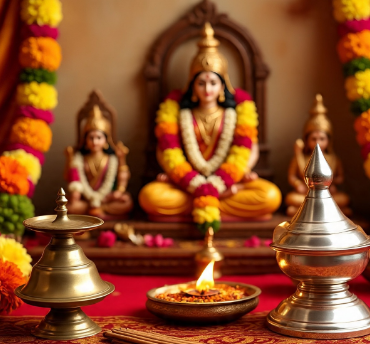Why Every Pooja Room Needs These Timeless Essentials
The essence of a pooja room remains the same: it is where faith meets focus, while modern interiors and lifestyles may have evolved. There are certain timeless essentials that every pooja room must include to maintain this sanctity. These elements create an aura of serenity, not only enhancing devotion. Let’s explore these essentials in detail.
1. The Centre of Devotion: Idols and Images of Deities
The idols and framed images of deities are at the heart of any pooja room. Around which rituals revolve, they form the spiritual centre. Considered pure and long-lasting, traditionally, idols are made of brass, silver, marble, or wood.
Idols should face the worshipper, not each other, and the space should be well-lit and adorned with flowers. Arranging deities with care is vital. Lord Ganesha for wisdom, Goddess Lakshmi for prosperity, Lord Shiva for peace, and so on; for several families, each deity represents a specific blessing. The pooja room transforms into a sanctuary of devotion when these divine figures occupy a place of honour.
2. For Daily Rituals Pooja Items
Without essential Pooja Items, no ritual is complete. To perform each step of worship with purity and precision, these tools and accessories help devotees. Commonly used items include:
- Dhoop & incense sticks – for purifying the atmosphere.
- Copper utensils & brass – to hold water, milk, or offerings, etc.
- Ghanti (a bell) – rung to invite the presence of the Supreme.
- Conch shell (shankh) – blown to dissolve negativity and mark auspicious beginnings.
- Chandan (sandalwood paste) and kumkum – for tilak and deity adornment.
- Sacred water from the Ganges – used for cleansing and purification.
Each of these Pooja Items carries spiritual significance. For example, just as incense burns, it releases fragrance, reminding us to transform our inner thoughts and spread positivity. Lighting incense symbolises transformation. Daily prayers are conducted seamlessly,
by having these items neatly arranged.
3. The Eternal Glow of Akhand Jyot
Keeping an Akhand Jyot (eternal flame) lit in the pooja room is one of the most sacred traditions in Indian households. Often fueled by ghee or oil, this flame symbolises uninterrupted devotion, divine presence, and the victory of light over darkness.
Lighting an Akhand Jyot is believed to:
- Draw prosperity and abundance.
- Shield the household from negativity.
- Strengthen spiritual power and focus.
- Create an environment of warmth and positivity.
Many families keep this flame burning continuously, ensuring it is never extinguished, especially during festivals or Navratri. Even if maintained for a few hours daily, the Akhand Jyot serves as a reminder of the unwavering connection between the devotee and the divine.
4. Holy Scriptures and Prayer Books
Without sacred texts and prayer books, a pooja room is incomplete. These scriptures enrich daily worship, from the Bhagavad Gita to the Hanuman Chalisa and other mantras. Reading or chanting from them creates vibrations that boost the spiritual environment and bring peace of mind.
Placing these books neatly in the pooja room also serves as a reminder to spend time each day in self-reflection and devotion. It becomes an early introduction to cultural values and traditions for children.
5. Symbols of Purity: Fresh Flowers and Offerings
In spiritual rituals, flowers hold a special place. To express devotion and purity, offering fresh flowers is an ideal way. Like marigold represents positivity, lotuses symbolise spiritual awakening, and jasmine denotes purity; each flower has a symbolic meaning.
Offerings are often made to deities, along with flowers, fruits, and sweets. As the offerings are later distributed as prasad, reinforcing the value of community and togetherness, this tradition reflects gratitude and sharing.
6. Sound and Fragrance – Inviting Divinity
To create an aura of peace and power, the ringing of bells, the blowing of a conch, and the chanting of mantras are considered to be auspicious practices. Similarly, fragrances from incense, camphor, and dhoop draw positivity into the house. To concentrate better during prayers, these sensory experiences help devotees awaken the mind.
7. Maintaining a Clean and Sacred Environment
A pooja room must always be kept clean, uncluttered, and peaceful. To ensure the energy flow remains pure, keep dust-free idols, polished brass lamps, and neatly arranged accessories. Considered sacred and antimicrobial, numerous families prefer to use copper or brass plates.
Final Thoughts
Whether big or small, every pooja room represents faith, discipline, and devotion. You are not only following tradition by including timeless essentials like pooja goods and the sacred Akhand Jyot, but also creating a spiritual haven within your home. These elements serve as constant reminders of positivity, gratitude, and the divine presence that guides daily life.
read more : Why Celebrities Can’t Get Enough Of Cabo Luxury Villas: Inside Their Luxury Getaways






